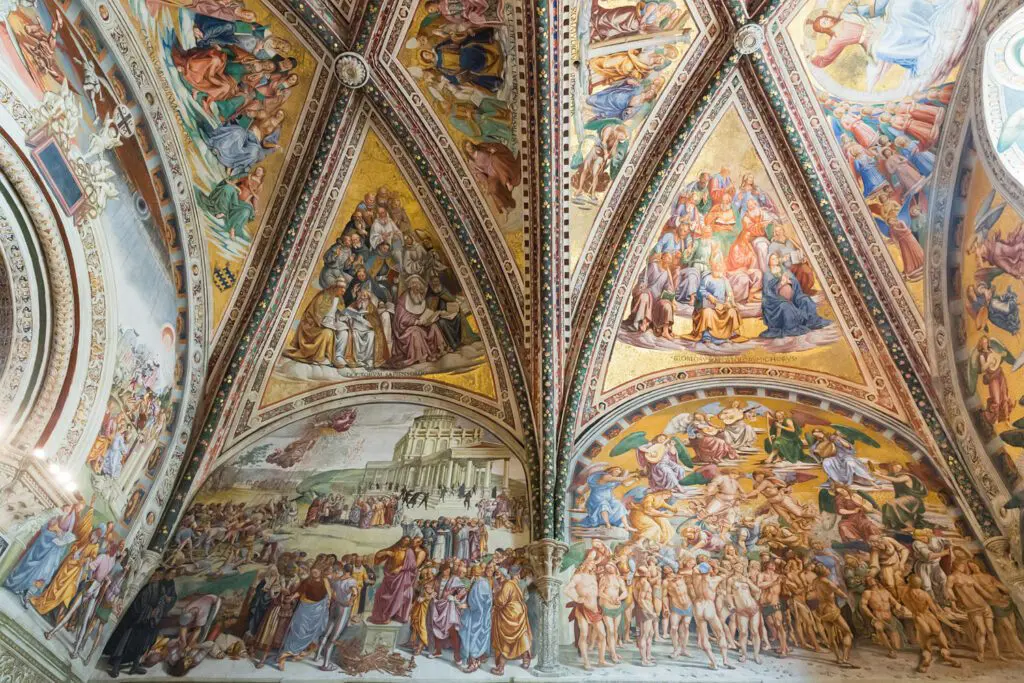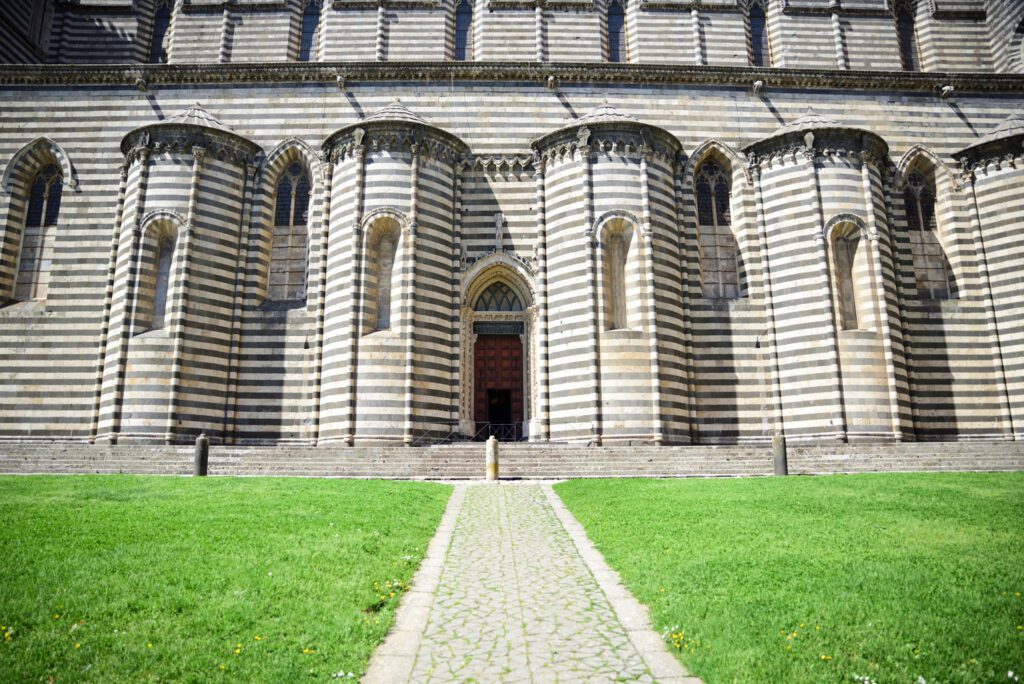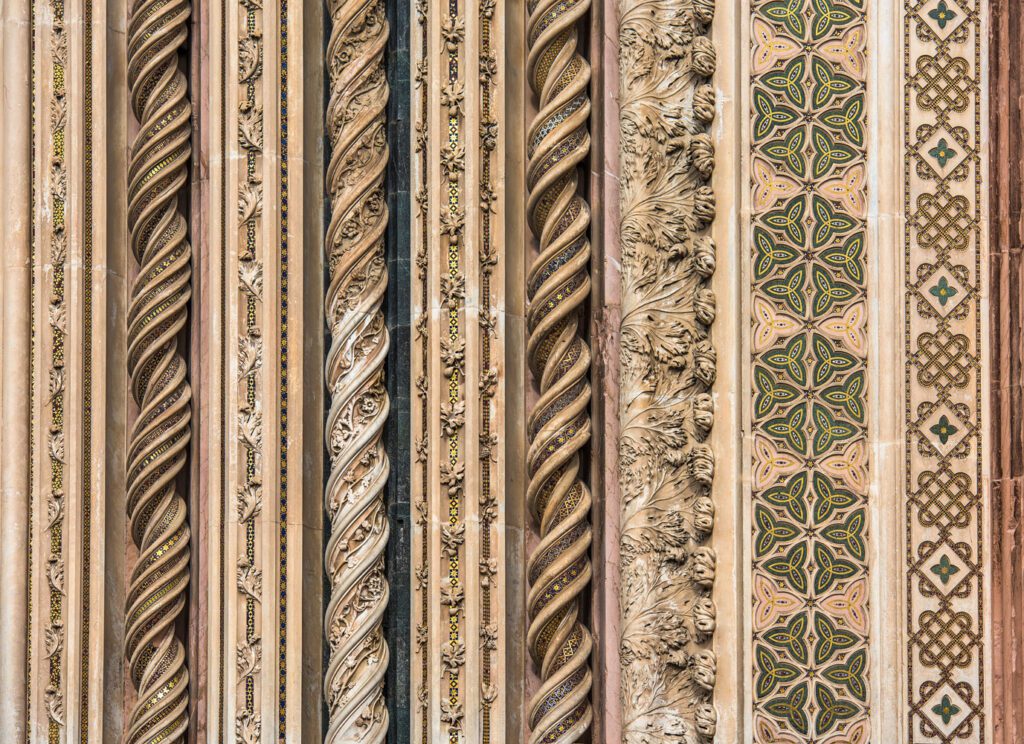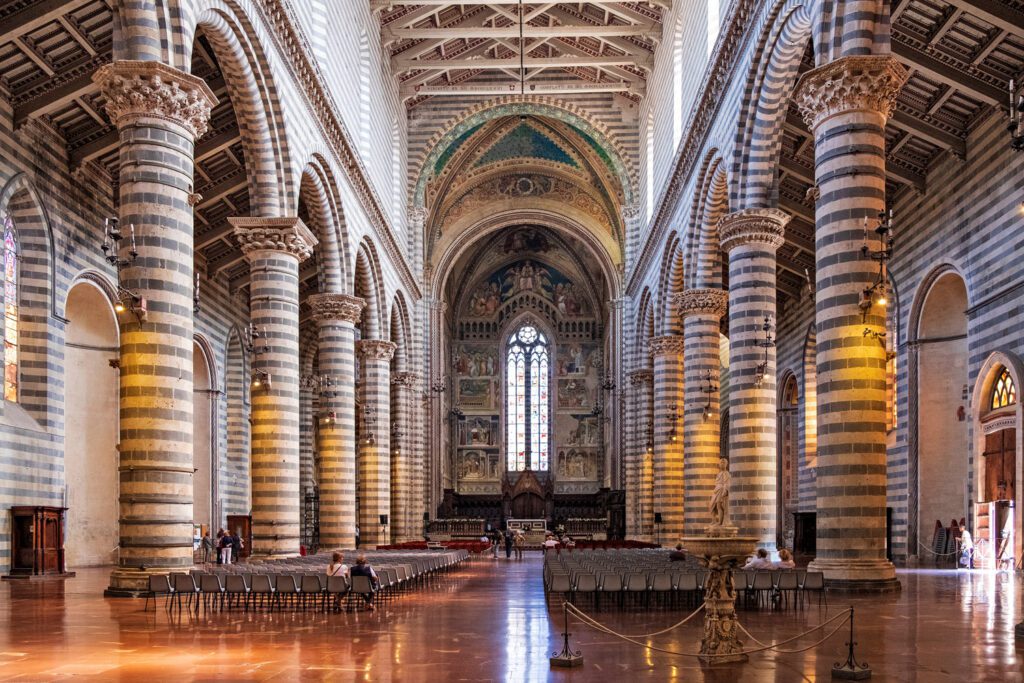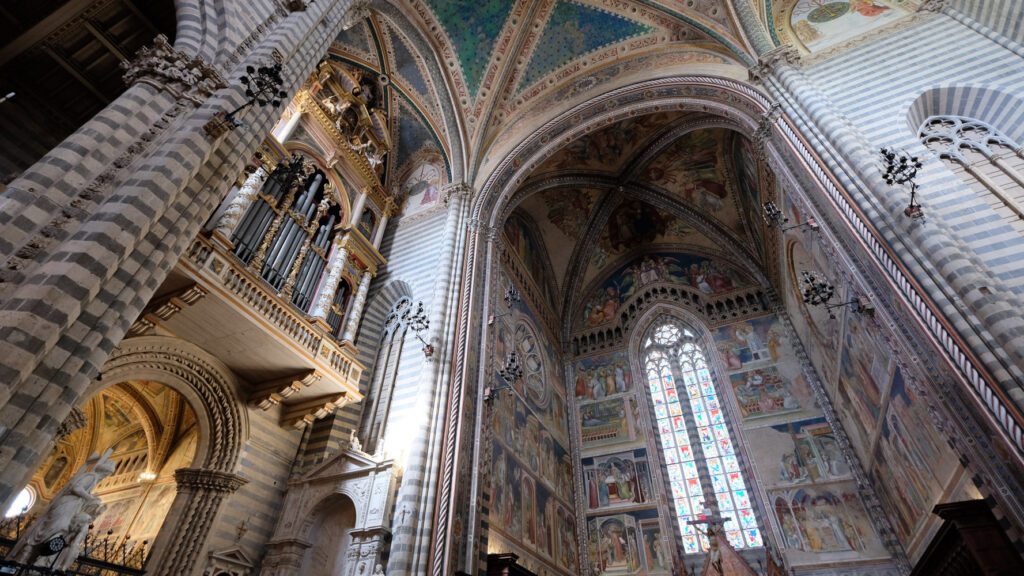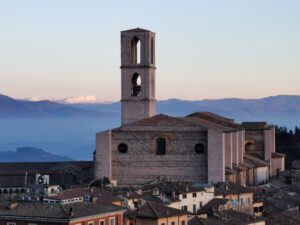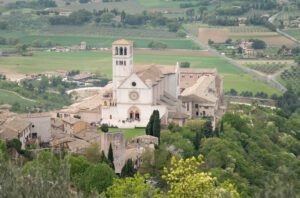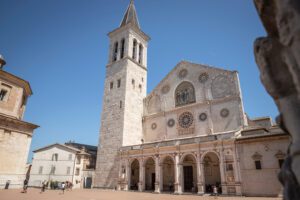The history of a centuries-old building site
At the end of 1200, Orvieto was a powerful town with a developed political and institutional structure. Right in that period, under the government of the Seven and the Town Council, the building site of the new cathedral was set directly upon the previous one, a smaller cathedral then in ruins, called Saint Mary de Episcopatu (“by the Bishop’s Palace”). The foreman entrusted with its construction was Brother Bevignate, who also worked on the Great Fountain in Perugia, together with the art supervisor, Ramo di Paganello.
In November 1290, the foundation stone of the Orvieto Cathedral dedicated to Saint Mary’s Assumption was layed in the presence of Pope Nicholas IV who recited the following blessing: “The Cathedral is a sign of the presence of God, as well as of an active and industrious Christian community; it shows the relationship between God and His people’s yearning. The bond with the town history and its inhabitants is so strong that still nowadays the Cathedral is Orvieto’s very symbol, the monument that most shapes its identity”.
Lorenzo Maitani’s building site
In 1310, twenty years after the job had been started, the project passed to Lorenzo Maitani (1275 – 1330), one of the greatest sculptors and architects at that time. He would make radical and definitive structural changes by creating a strongly Gothic space, a Latin-cross-shaped building whose wings include two big, important chapels, and a tricuspidal (three-vertex) façade. He remained the foreman until his death in 1330.
The history of the Orvieto Cathedral does not only include artists and buyers, but also all those people, workers and craftsmen, who day by day shared in the raising of the church. It is still possible to imagine a living building site, the town’s working core;a place filled with construction materials, where the workers’ chatting merged with the fire crackling from the furnaces of the glass-makers, as well as the din from the tools of carvers and stone breakers, blacksmiths and carpenters.The building grew with the aid of everybody, under the leadership of the foreman, Lorenzo Maitani. After him, many others from all over Italy would take on the same role during the two following centuries, until the work was completed.
Decorations of the façade of Orvieto Cathedral
Sculptures
The Cathedral façade is a visual narrative that recounts the history of Salvation, well visible in a mix of architecture, sculptures, and mosaics. The visitor’s eyes are led toward the sky by vertical lines stressed by the four main pillars, the cusps, and the steeples. Verticality is counterbalanced by the horizontal lines that separate the different levels.
Looking bottom to top, it is possible to admire the three huge and deep gates, whose splays and arches house thin spiral pillars decorated with different kinds of marble. In the areas between the gates lie the basements of the main pillars, covered with marble slates and embellished with low reliefs that are among the most important specimens in Italian Gothic sculpture. By showing episodes of the Old and New Testaments, plus the Last Judgment, they make sort of a sculptured Bible that can be examined until get lost in details.
Above the marble decorations, four bronze statues (actually copies; the original versions are in the Museum) representing the Evangelists by means of the Four Living Beings are placed: an angel (Saint Matthew), a lion (Saint Mark), an eagle (Saint John), a bull (Saint Luke). Statues of Saints stand on the steeples and on the vertexes of the cusps. Horizontally, the façade area is further divided by an exterior gallery with three-lobed arches.
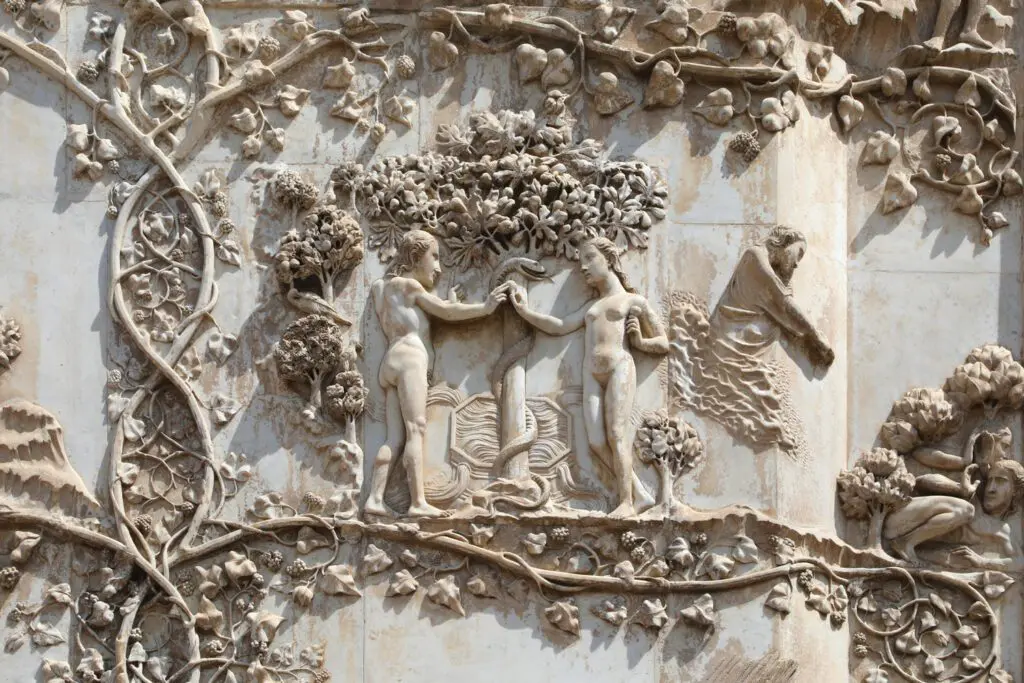
The rose window
In the centre of the façade there is the rose window of the Orvieto Cathedral, made by Andrea di Cione, a sculptor from Florence known also as “Orcagna” (1354 – 1380). The circle, inscribed within a square, is internally decorated with small interweaving arches, supported by thin pillars, and in its center, Jesus Christ’s face is carved. This rose window reveals itself as a powerful symbol of Christian faith, representing Christ as the core of God’s plan for the salvation of humankind. All along the perimeter of the square, 52 stone heads are inserted, representing Prophets and Apostles.
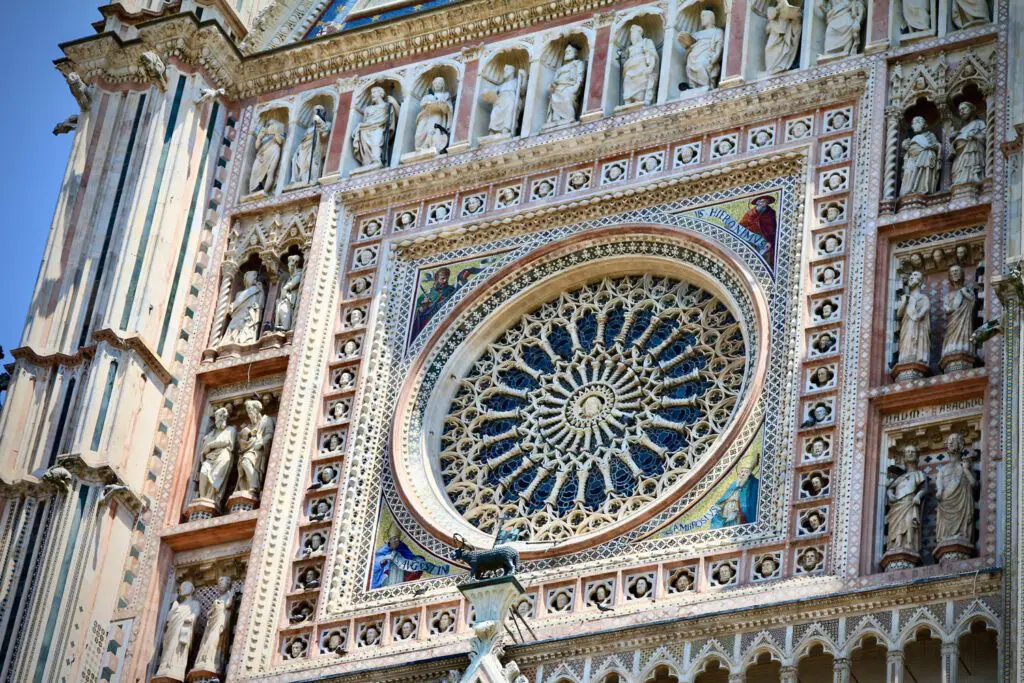
Mosaics
The mosaic decoration fills every part in the façade that is not taken up by sculptures. Since the Orvieto Cathedral is dedicated to Virgin Mary, she is the subject matter of decorations; in fact, the scenes narrate her story. Unfortunately, most mosaics have been heavily reworked during the centuries. The only original work left had been designed by Ugolino di Prete Ilario and made into a mosaic by a Franciscan friar, Brother Giovanni Leonardelli, in the second half of the 14th century. In 1890, however, it was sold to the Victoria and Albert Museum in London, where it is still exhibited.
The Interior of the Orvieto Cathedral
The Naves
As a theologian and philosopher, Romano Guardini wrote: “A cathedral is not mere architectural space, it is a spatial substance that pulsates and breathes” ((in L’opera d’arte, 1988). The space inside the Orvieto Cathedral is a wide and majestic gathering point for art and faith. Like the external sides, the interior is typically decorated with bands in travertine (white) and basalt (gray), and it is divided in three naves covered by wood trusses. The space, recalling the ancient Roman basilicas (public halls, not churches), is made solemn by the vertical dynamics of the walls, the ten central pillars, and the light effects from the alabaster sheets in the windows. Each visible architectural element leads one’s soul upward.
The floor is in red limestone from Prodo (a place near Orvieto). The side naves are made livelier by two sets of five semicircular chapels. In the left nave, especially to be admired is a 1423 fresco by the famous painter Gentile da Fabriano (1370 – 1427), depicting Virgin Mary enthroned together with a smiling Infant Jesus, who grasps one of his mother’s fingers in an attitude of moving tenderness.
The apse was frescoed by Ugolino di Prete Ilario between 1370 and 1380 with episodes from Virgin Mary’s life. Quite striking are the colors projected by the light from the big central window, dating back to 1334, composed of 44 glass panels made by Giovanni di Bonino. The heads of the transept house the two most important chapels: the Chapel of the Corporal and the Chapel of Saint Brizio.
The Chapel of the Corporal
This chapel keeps the relic of the Holy Corporal, that is a linen cloth stained by true blood drops that fell from a consecrated wafer during a Mass in the town of Bolsena in 1263. The story of this miracle is reported on the walls, in the frescoes made by Ugolino di Prete Ilario in 1357-1364; however, the most precious work of art here is the reliquary made by a goldsmith, Ugolino di Vieri, in 1337.
The Chapel of Saint Brizio
This chapel exhibits some of the most surprising examples of 15th century Italian painting. The vault was entirely frescoed by Fra Angelico between 1447 and 1449, while the walls were frescoed by Luca Signorelli in the years 1449-1504. This space is dedicated to Orvieto‘s patron saint and the frescoes represents scenes from the Last Judgment.
